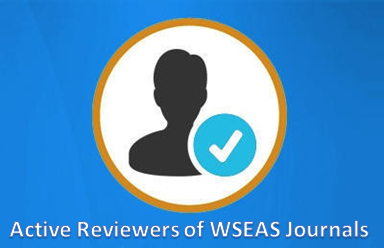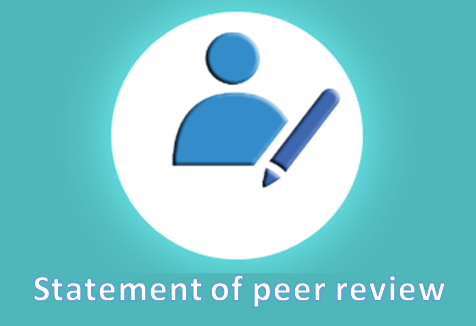
WSEAS Transactions on Advances in Engineering Education
Print ISSN: 1790-1979
E-ISSN: 2224-3410
Volume 12, 2015
Notice: As of 2014 and for the forthcoming years, the publication frequency/periodicity of WSEAS Journals is adapted to the 'continuously updated' model. What this means is that instead of being separated into issues, new papers will be added on a continuous basis, allowing a more regular flow and shorter publication times. The papers will appear in reverse order, therefore the most recent one will be on top.
Volume 12, 2015
Title of the Paper: On Approximations by Polynomial and Trigonometrical Splines of the Fifth Order
Authors: I. G. Burova, T. O. Evdokimova
Abstract: Here we consider several approaches for constructing approximations of a function by the polynomial and the trigonometric splines of the fifth order. We compare the approximations to the left, the right and the mid-le minimal polynomial splines, the approximations to the left, the right and the middle minimal trigonometrical splines, the approximations to the left, the middle polynomial integro-differential splines, and the approximation to the left, the right and the middle trigonometrical integro-differential splines. The quadrature formulas are represented. The results of some calculations are done.
Keywords: Polynomial splines, Trigonometrical splines, Integro-Differential Splines, Interpolation
WSEAS Transactions on Advances in Engineering Education, ISSN / E-ISSN: 1790-1979 / 2224-3410, Volume 12, 2015, Art. #13, pp. 124-136
Title of the Paper: New Software Package for Teaching and Learning the Basics of Photovoltaic System Sizing
Authors: Sebastien Jacques, Sebastien Bissey
Abstract: This paper describes an innovative and highly modular software tool named PVLab and developed by the GREMAN laboratory in collaboration with Polytech Tours from the University of Tours (France). This simulation package assists the designer in the sizing of PV (photovoltaic) installations. PVLab has a high level of flexibility, allowing its physical models and databases (e.g., meteorological data) to be modified according to the user’s needs. This is made possible through the use of expertise applied to all of the computing steps, and to the MATLAB development environment. The user’s ability to control the source code itself will allow much greater progress to be made in the field of renewable energy applications than with PVsyst, which is currently the commercial reference. All of these features come together to make PVLab the perfect tool for modernizing higher education, in particular with regard to students’ competencies.
Keywords: Solar energy, Photovoltaic, Powerful software package, Attractiveness of education
WSEAS Transactions on Advances in Engineering Education, ISSN / E-ISSN: 1790-1979 / 2224-3410, Volume 12, 2015, Art. #12, pp. 115-123
Title of the Paper: Optimization of the Mass for a Low-Power Electric Vehicle and Consumption Estimator (E-Bike, E-Velomobile and E-Car)
Authors: A. Sivert, F. Betin, B. Vacossin, T. Lequeu, M. Bosson
Abstract: The design and optimization of the motor vehicle is a multidisciplinary problem that must consider the average speed, average elevation, resistive power, vehicle mass, luggage mass, motor mass, aerodynamics, performance, mechanical constraints, etc. The search to minimize cost and maximize autonomy adds to the difficulties of making technology choices. In recent years, the e-bike and e-motorcycle are marketed but what is optimal based on the weight of the battery and motor? What is the potential average speed without using the electric motor? What are the performances (consumption and acceleration) of a vehicle based on the added mass? What will be the autonomy of an e-bike based on its mass? To answer these questions, the actual performance of an e-bike and a fully faired e-velomobile along with the optimization coefficients will be presented. This e-velomobile provides a range of about 200 km at an average speed of 50 km/h for a mass of 50kg including the electric motor and a fairing that also provides protection against inclement weather. This e-velomobile is a single-passenger vehicle for someone up to 100kg plus 30 kg of luggage. Electric power consumption is only €1 per 2000 km and the charging time is one hour on a standard outlet. On a long route, average speed depends on the average grade of the road. Therefore, a consumption estimator can be used to determine the average speeds the vehicle can achieve without the risk of running the batteries empty. The electric bike is an excellent educational tool because all students can use it without any safety issues. When pedaling, the student can identify with the motor drive and understand the meaning of torque, speed and power.
Keywords: Mass optimization, Eco Marathon Challenge, Motor power, Lithium battery, Project-based teaching, Energy management, e-bike, e-velomobile, electric car, Consumption estimator, Autonomy
WSEAS Transactions on Advances in Engineering Education, ISSN / E-ISSN: 1790-1979 / 2224-3410, Volume 12, 2015, Art. #11, pp. 105-114
Title of the Paper: Pedagogical Study of Electric Go-Karts: Technological Choices, Instrumentations, Characteristics, Challenge
Authors: Arnaud Sivert, Franck Betin, Thierry Lequeu, Francois Maeght
Abstract: Electric vehicles are very good educational aids because they can be used by every student with lower costs compared to building a classic car. The International Pedagogical electric go-kart Meeting that take place in France motivates students and help them to implement different technological choices. These choices are often difficult because they mean saving the energy aboard, in accordance with new technologies. Indeed, these future vehicles represent a difficult compromise between weight, volume, power, autonomy, and price. The evolution of electric go-karts was made possible thanks to motors running on low voltage and new Lithium batteries. This article will outline the resisting power depending on the vehicle speed, accelerating torque, types of motors and controllers used, energy sources and chargers. Finally, one educational application will be pre-sented as this kind of vehicles uses many aspects of electrical engineering: power converter, battery, motor, controller, control, electronics, lights, instrumentation, sensor, mathematics, mechanics…
Keywords: go-kart challenge, motor electric control, Lithium battery, project-based teaching, battery charger, super capacity, instrumentation
WSEAS Transactions on Advances in Engineering Education, ISSN / E-ISSN: 1790-1979 / 2224-3410, Volume 12, 2015, Art. #10, pp. 95-104
Title of the Paper: The “Missing Species” – Female Students in STEM-Fields. A Qualitative Study on Young Austrian Female Students in Gender-Typical Disciplines and STEM-Fields
Authors: Barbara Friehs
Abstract: Even though women in Europe, nowadays, have reached the highest education level ever in history, they are still underrepresented in STEM-fields. This study tries to identify factors that make young women opt for a gender-typical or gender-atypical study discipline. Especially the impact of teachers is focused on. 36 young women (n=36) were interviewed on motives related to their choice of academic studies. Various career choice theories form the theoretical framework. Recommendation on how to possibly raise the number of females in STEM-fields by improving the conditions in the school context conclude the study.
Keywords: Technical education, gender gap, female students in STEM-fields
WSEAS Transactions on Advances in Engineering Education, ISSN / E-ISSN: 1790-1979 / 2224-3410, Volume 12, 2015, Art. #9, pp. 86-94
Title of the Paper: Motivation for Maintaining a Constant Workload During a Mathematics Course for Engineers
Authors: Lassi Korhonen, Merja Maikkola, Raimo Kaasila
Abstract: Motivation to study is a crucial factor in passing courses. The problem of the lack of motivation is often present especially in mathematics courses for engineers because the relation between mathematics and engineering studies is not clear enough for students. In this paper, we analyze and present the reasons for students’ initial motivation and the factors promoting motivation in a mathematics course for engineers. The analysis is based on qualitative data collected between 2010 and 2013 and on quantitative data collected from student interviews. In addition, we introduce pedagogical tools and analyze their effect on students’ motivation to maintain a constant workload. According to the results, the tools proposed encourage students to work hard during the course, and the work done positively affects their learning results and the pass rate for the course. An important observation was also the fact that external factors like rewards from different tasks can support enough student’s motivation to study the whole course.
Keywords: Study Motivation, Extrinsic Motivation, Engineering Mathematics, Constant Workload
WSEAS Transactions on Advances in Engineering Education, ISSN / E-ISSN: 1790-1979 / 2224-3410, Volume 12, 2015, Art. #8, pp. 74-85
Title of the Paper: Training Future Engineering Students to Information Literacy: a Challenge for Academic and Professional Success
Authors: Amrous N., Bennani S., Daoudi N., Ettaki B.
Abstract: Information literacy in the present era, which is characterized by the multitude of information sources, information explosion, and the rapid development of information technology and communication, has become a must for the effective use of scientific and technical information for both academic and professional success. This article focuses on information literacy of future engineering students. It presents results of a study conducted among a sample of students who reveal shortcomings and gaps in information retrieval in this category. It then proposes ways of intervention for engineering schools in order to facilitate the development of these skills in the academic community.
Keywords: Information Literacy, engineering students, information competency, academic librarians, training program, higher education
WSEAS Transactions on Advances in Engineering Education, ISSN / E-ISSN: 1790-1979 / 2224-3410, Volume 12, 2015, Art. #7, pp. 63-73
Title of the Paper: A New PC-Based Workbench for Virtual Instrumentation and Automatic Control Using Matlab GUI/MEX-C++ Application
Authors: Jean Mbihi
Abstract: This paper presents an original PC-Based Workbench for virtual instrumentation and automatic control. Its software platform results from a mix of Matlab Graphical User Interface (GUI) design and Matlab Executable (MEX) C++ programming. It is shown how a sophisticated custom MEX C++ control library, callable from Matlab GUI application, has been built from the C++ driver of an arbitrary data acquisition board. The varieties of simulation and experimentation modes provided include: digital-to-digital controls, digital-to-analog and analog-to-digital conversion, open loop control, and Matlab GUI/MEX controllers. A sample of simulated and experimental results obtained and presented, shows the great merit of the proposed well tested PC-based workbench in control engineering education.
Keywords: PC-Based Workbench, Virtual instrumentation, Automatic control, Matlab GUI, MEX-C++, mexFunction, data acquisition board, Advanced Programming, Matlab/MEX controllers
WSEAS Transactions on Advances in Engineering Education, ISSN / E-ISSN: 1790-1979 / 2224-3410, Volume 12, 2015, Art. #6, pp. 52-62
Title of the Paper: Service Composition Algorithm: Student Assessment & Course Evaluation
Authors: Yousra Chtouki, Hamid Harroud, Mohammed Khalidi Idrissi, Samir Bennani
Abstract: Service composition is a widely addressed subject that has enforced itself on businesses due to the interchanged and mixed interests among companies and institutions. Each business is in need of collaborating with other businesses, this requires the need for using multiple services and applications from different providers. From that the need for service composition has become necessary. Education is a field where service composition can solve many problems; such as providing an educator with the desired services even if they do not exist in the LMS ‘learning management system’. A new service can be composed based on existing services even if they reside in different locations and by different providers. In education for each given course a course Portfolio is an important component. For that we have chosen it to establish our proposed solution for service composition. This work defines the basics for several applications in service composition in general and in E-Learning in particular. Future work includes a translator can be added to the current system to translate the user’s request from natural language also users could choose be provided with the search results and be able to pick the services he/she wants to compose.
Keywords: Web Service composition, policies, e-learning, course portfolio, student assessment, policy based orchestration
WSEAS Transactions on Advances in Engineering Education, ISSN / E-ISSN: 1790-1979 / 2224-3410, Volume 12, 2015, Art. #5, pp. 42-51
Title of the Paper: Development of an Android Based Game Interfaced with QR Codes for a Gamified Power Management System
Authors: Mariano Jesus M. Cayabyab Jr., Maria Rosa T. Santiago, Samuel Matthew G. Dumlao, Rosula S. J. Reyes
Abstract: Filipinos are under the threat of an energy shortage. While efforts are being done both in the public and private sectors in developing alternative solutions to ease the shortage, it will take several years before this will come to full implementation. Conservation of energy through power management is the simplest and closest to implement at this time. Filipino households need to be motivated to use smart energy conservation. The introduction of Gamification as a method of motivations has found its use in many applications. In this study the possibility of Gamification to encourage the use of smart energy conservation is tested. In this study three game elements were used to develop the model for the game; these elements include incentives, competition and feedback. These three elements were implemented in an android game through a three step process; namely the Game Design where the theoretical framework of the game was created’ Game Implementation where the researchers create the functions for the game using the Java language and Eclipse IDE, and the Game Deployment where the researchers perform a bug test and advertise the project using Social Media and Live Advertising. The use of QR Codes was implemented for the participants to control switching on and off of appliances in the selected rooms.
Keywords: Smart Energy Conservation, Gamification, QR Codes, Positive Reinforcement, Game Design, Game Implementation, Game Deployment
WSEAS Transactions on Advances in Engineering Education, ISSN / E-ISSN: 1790-1979 / 2224-3410, Volume 12, 2015, Art. #4, pp. 31-41
Title of the Paper: Single Quality Model in Software Life Cycle
Authors: Rudite Cevere, Sandra Sproge
Abstract: The article deals with the problems associated with quality definition and assessment for software development processes, intermediate and end products throughout the entire software life cycle. The main objective of the research is to develop measures to improve software quality. It is known that it is not possible to develop a software which is free from problems. Therefore methods and techniques of software quality improvement are still being developed intensively. Our work is based on years of experience in IT companies and higher education institution. In the information technology sector a lot of attention has been paid to Software Quality Assurance. Our experience has led to the hypothesis that software quality model can be generalized and applied to description and evaluation of quality in a wider area, including quality of the processes. The extended software product quality life cycle is offered including the study process, because during it the future IT professionals acquire their basic knowledge. When starting any quality evaluation activity, at first it is necessary for all stakeholders to agree on a definition of quality. In our work a single quality model and its application procedure has been developed based on quality model defined in standard ISO / IEC 9126.
Keywords: Quality Model, Software Product Quality, Internal and External Quality Model, Quality Assurance, Study Programme, Study Courses
WSEAS Transactions on Advances in Engineering Education, ISSN / E-ISSN: 1790-1979 / 2224-3410, Volume 12, 2015, Art. #3, pp. 19-30
Title of the Paper: Design of Optimal IIR Digital Filter Using Teaching-Learning Based Optimization Technique
Authors: Damanpreet Singh, J. S. Dhillon
Abstract: In this paper an Enhanced Teaching-Learning Based Optimization (ETLBO) algorithm is employed to design stable digital infinite impulse response (IIR) filter using Lp-norm error criterion. The original TLBO algorithm has been remodeled by merging the concept of opposition-based learning and migration for selection of good candidates and to maintain the diversity, respectively. The multiobjective IIR digital filter design problem considers minimizing the Lp-norm approximation error and minimizing the ripple magnitude simultaneously while satisfying stability constraints on the coefficients of the filter. Weighted sum method and p-norm method are applied to solve the multicriterion optimization problem . Best weight pattern is searched using evolutionary search method that minimizes the performance criteria simultaneously. The validity of the method is demonstrated for the design of low pass (LP), high pass (HP), band pass (BP) and band stop (BS) IIR filters. The comparison of simulation results with other existing methods show that the proposed ETLBO algorithm is superior in terms smaller L1-norm error, L2 -norm error and smaller pass band and stop band ripples.
Keywords: IIR filter, TLBO, magnitude response, stability, Lp-approximation error
WSEAS Transactions on Advances in Engineering Education, ISSN / E-ISSN: 1790-1979 / 2224-3410, Volume 12, 2015, Art. #2, pp. 9-18
Title of the Paper: Automatic Learning Path Design: Development and Implementation
Authors: Agostino Marengo, Alessandro Pagano, Giulio Monopoli
Abstract: This paper will describe the development and implementation of an Adaptive System Prototype with the aim to manage an automated and customized learning experience. After the first in-depth study on the usefulness and effectiveness of personalized learning approach, the research team intended to fill the gap between the theory of personalized learning environments and its practice trough the development of an adaptive learning plugin implemented on mostly used, Open Source, Learning Management Systems. The developed technology, follow the goal to identify any end user of the LMS, create a customized user profile with their starting skills and learning preferences in order to automatically tailor a personalized learning path. The main purpose is to maximize student’s performance. This paper describes the main steps for the implementation of the prototype of this Adaptive Learning System named iO3 (intelligent Open Cube), as it will be an intelligent, Open Source, Open Learning, Open Plugin system.
Keywords: Adaptive learning, Automatic Learning Path design, e-learning, Personalized Learning Environments
WSEAS Transactions on Advances in Engineering Education, ISSN / E-ISSN: 1790-1979 / 2224-3410, Volume 12, 2015, Art. #1, pp. 1-8



